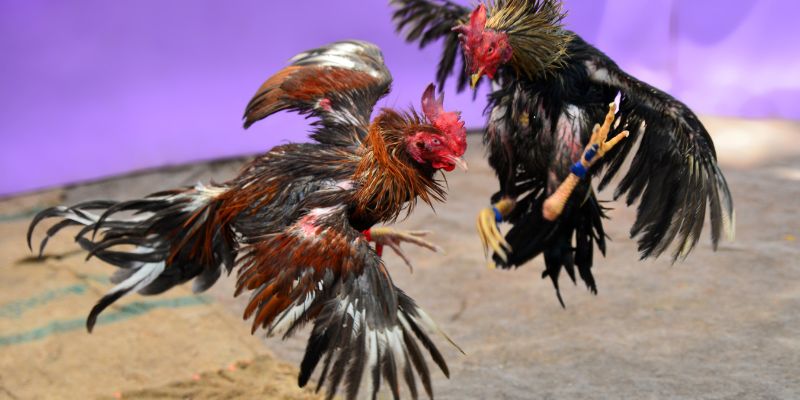Training fighting cocks is one of the important issues that cock breeders need to pay attention to in order to develop and improve the fighting ability of the cocks. With passion and love, training not only helps the cocks become stronger but also brings joy to the owners. In this article, Jun88 will explore together different aspects ofcockfighting trainingfrom breed selection, nutrition to training techniques.
Learn about fighting cocks

Fighting cocks are chickens raised for fighting and are often considered a symbol of strength and courage in the cultures of many countries, especially in Vietnam. To be able tocockfighting trainingTo be effective, we first need to understand their biological characteristics and personalities.
Physiological characteristics of fighting cocks
Fighting cocks have a graceful, strong shape with strong feathers. These characteristics are important factors that help the cocks to be agile and flexible in matches.
The musculoskeletal system of fighting cocks is also very developed, helping them to move flexibly and react quickly. This is extremely important in helping them avoid attacks from opponents.
A prominent feature of fighting cocks is their aggressiveness and fierceness in fighting. They often have a strong fighting spirit and do not give up easily, which also makes it difficult tocockfighting trainingbecome more interesting.
Personality of fighting cock
Gamecocks have a very distinctive personality. They are often very confident, even a bit arrogant. However, during training, this personality can be lost if not properly controlled.
The personality of fighting cocks also changes according to each stage of development. In the early stages of life, they are often very active and mischievous, but as they get older, they become calmer and more assertive. Understanding this personality will help breeders have methodscockfighting training Fit.
The influence of living environment
The living environment has a great impact on the development and personality of fighting cocks. If raised in a friendly, safe environment, they will develop better. On the contrary, if placed in a stressful environment, chickens can become more aggressive or, conversely, become shy.
Creating a suitable living environment is one of the important factors incockfighting trainingFactors such as space, light, and sound all play a decisive role in the psychology and health of chickens.
Selecting fighting cock breeds
Choosing the right breed of fighting chicken is the first and extremely important step to be able tocockfighting trainingsuccess. Good chicken breeds not only ensure health but also have the potential to develop fighting skills.
Criteria for selecting fighting chicken breeds
When choosing a breed, breeders need to pay attention to many different criteria. The first is the genetic origin, that is, determining whether the chicken comes from good breed lines or not. Breed lines with a long history of achievements in matches will often have many outstanding advantages.
Next is appearance. Fighting cocks need to have a balanced body, moderate height and parts such as legs and wings need to be strong.
Finally, health is also an indispensable criterion. A healthy chicken will reduce the risk of disease and its fighting ability will be better.
Benefits of choosing good breeds
Choosing good breeds not only helps chickens have good fighting ability but also helps them develop comprehensively both physically and mentally. Healthy fighting chickens will be less susceptible to disease, helping breeders save time and care costs.
In addition, good breeds can also pass on good characteristics to the next generation. This helps maintain the breed and improve the quality of fighting chickens in the future.
How to choose breed
In fact, breeders can choose breeds through many different methods. Some people choose breeds from reputable farms that have a reputation for quality fighting chickens.
In addition, breeders can also consult with experts in the industry or join online groups to gather more information. Either way, breed selection must always be done seriously and carefully.
Nutrition for fighting cocks
Nutrition is an extremely important factor incockfighting trainingA healthy chicken needs a proper diet to ensure enough energy for daily activities as well as competition.

Essential nutrients
For fighting cocks to grow healthily, their diet needs to include adequate nutrients such as protein, carbohydrates, vitamins and minerals.
Protein is important for building muscle. Farmers can supplement protein for chickens by feeding them meat, fish or industrial feeds that contain high protein content.
Carbohydrates provide energy for chickens to function. Grains or seeds are also a good source of carbohydrates.
Vitamins and minerals help chickens increase their resistance and prevent diseases. Green vegetables and fresh fruits are great sources of vitamins for chickens.
Feeding time
Feeding timing is also very important incockfighting training. An irregular diet can lead to poor health. Farmers should organize chicken feeding according to a specific schedule, usually 2-3 meals a day is reasonable.
In addition, it is important to pay attention to feeding before the competition. Chickens should be given a light meal before the competition to ensure that they do not have a heavy stomach, but still have enough energy to compete.
Food preparation methods
Farmers also need to know how to prepare food to suit the chickens’ taste. Some chickens may prefer pelleted food, while others prefer wet food.
Changing the way food is prepared also helps chickens avoid boredom, thereby improving their ability to absorb nutrients. A varied diet also helps improve chickens’ resistance.
Fighting cock training techniques
Training techniques are the deciding factor in the fighting ability of fighting cocks. Even if a cock has a good breed and is well-nourished, if it is not properly trained, it will not be able to maximize its potential.
Physical exercises
Exercise is an indispensable part of the process.cockfighting trainingRunning, jumping and flying exercises will help chickens increase strength and agility.
Long distance running exercises help chickens increase their endurance, while high jumping exercises will help chickens increase their reflexes.
In addition, breeders can also use toys to encourage chickens to exercise. Simple but stimulating toys will help chickens become more flexible.
Combat training
Combat training is the most important part of the process.cockfighting training. Breeders can use techniques such as simulated fights to help their chickens get used to the pressure of competition.
During each training session, the breeder needs to create a safe but challenging enough competition environment for the chickens to develop their skills.
It is important to note that fighting chickens should not be pushed too hard to avoid injuring them. Patience and persistence in training will bring positive results.
Psychology of fighting cocks
Psychology is also a decisive factor in the fighting ability of chickens. Breeders need to create conditions for chickens to feel comfortable and confident when entering the match.
Creating relaxing times will help keep your chickens stress-free and ready for any challenge. You can use soft music or arrange a quiet space for your chickens to rest.
Conclude
On the journey cockfighting training, grasping knowledge from breed selection, nutrition to training techniques is extremely necessary. Each fighting cock has its own characteristics and training requirements. Therefore, breeders need to be patient, take good care of them and regularly monitor their development.
Hopefully with the above sharing, readers will have more valuable information to apply to their work.cockfighting trainingof your own, thereby bringing success and joy in this hobby and passion.


